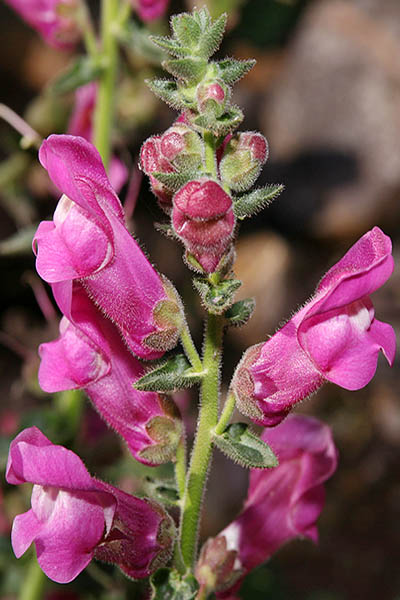Hebrew: לוע-ארי הגדול, Arabic: گل میمون
| Scientific name: | Antirrhinum majus L. | |
| Common name: | Common Snapdragon | |
| Hebrew name: | לוע-ארי הגדול | |
| Arabic name: | گل میمون | |
| Family: | Scrophulariaceae, לועניתיים |

|
| Life form: | Chamaephyte | |
| Stems: | 15-90cm high; plants with dark colored flowers have dark green or reddish stems and those with white or pale flowers have pale green stems | |
| Leaves: | Alternate, simple, entire, oblong; spatulate; more than 3 times as long as wide | |
| Inflorescence: | Flowers zygomorphic, in terminal, bracteate racemes | |
| Flowers: | Bracts ovate to ovate-lanceolate; pedicels 2-10mm; calyx lobes, ovate-oblong to suborbicular, obtuse; corolla, pink, violet | |
| Fruits / pods: | Ovoid capsule 10-14 mm diameter, containing numerous small seeds | |
| Flowering Period: | April, May | |
| Habitat: | Hard rock outcrops | |
| Distribution: | Mediterranean Woodlands and Shrublands, Montane vegetation of Mt. Hermon | |
| Chorotype: | Mediterranean | |
| Summer shedding: | Perennating |
|
Derivation of the botanical name: Antirrhinum, from Greek anti (αντι), "like," and rhis (ριϛ, ινοϛ), "nose", inus (-ινοϛ), probably referring to the nose-like capsule in its mature state. majus, bigger, larger. The Romans called it leonis ora, or “lion’s mouth.” The Old French word for Snapdragon was muflier, or “snout”; the Italians called the flower bocca de leone, and the Germans Löwenmäul, which both mean “lion’s mouth.” The Hebrew word: לוע-ארי, loah-arie, “lion’s mouth.”
|